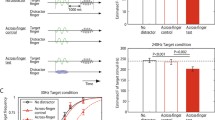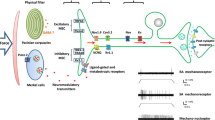Summary
The human capacity to scale the intensity of brief mechanical indentations of the hairy skin was measured by the method of subjective magnitude estimation. The afferent discharges evoked by nearly identical stimuli delivered to comparable locations on the hairy skin in monkeys were recorded in a number of types of first-order mechanoreceptive afferents. It was shown that of these only those which adapt slowly to mechanical stimuli possess sufficient dynamic range of response to account for the range of human pressure sensation. Two such afferents innervating the hairy skin, previously identified by others as the Type I and Type II afferents, were studied in detail as regards their responses to brief mechanical stimuli of different intensities.
The relation of the human subject's estimate of intensity to stimulus magnitude is described by a power function with an exponent of about 0.4. Using impulse frequency in the “early steady state” as a measure, the responses of both types of slowly adapting mechanoreceptive afferents are related to stimulus magnitudes by power functions with exponents averaging about 0.5. On the assumption that the stimuli used elicit similar patterns of discharge in the first-order afferents innervating the hairy skin of men and monkeys, the results support the general proposition, now shown to hold for a number of senses, that the intensity of human sensation is determined by the functional properties of the first-order sensory fibers, and that the final behavioral output in the form of a subjective estimate of magnitude is a linear function of the frequency of discharge in those first-order fibers.
Similar content being viewed by others
References
Borg, G., Diamant, H., Ström, L., Zotterman, Y.: The relation between neural and perceptual intensity: A comparative study on the neural and psychophysical response to taste stimuli. J. Physiol. (Lond.) 192, 13–20 (1967).
Brown, A.G., Iggo, A.: A quantitative study of cutaneous receptors and afferent fibres in the cat and rabbit. J. Physiol. (Lond.) 193, 707–733 (1967).
Chambers, M.R., Iggo, A.: Slowly-adapting cutaneous mechanoreceptors. J. Physiol. (Lond.) 192, 26–27P (1967).
Prey, M. von: Untersuchungen über die Sinnesfunktionen der menschlichen Haut; Druckempfindung und Schmerz. Abh. sächs. ges. Wiss., math.-phys. Cl. 23, 175–266 (1896).
—: Die vier Empfindungsarten des Drucksinns. Z. Biol. 79, 303–306 (1923).
—: Die Tangoreceptoren des Menschen. In: Handbuch der normalen und pathologischen Physiologie, Vol. XI. Ed. by A. Bethe, G. von Bergman, G. Embden, and A. Ellinger. Berlin: Springer 1926.
—: Goldman, A.: Der zeitliche Verlauf der Einstellung bei den Druckempfindungen. Z. Biol. 65, 183–203 (1915).
—: Rein, H., Strughold, H.: Beiträge zur Frage des tiefen Drucksinns. Z. Biol. 82, 359–377 (1924).
—, Strughold, H.: Ist der Drucksinn einheitlich oder zwiespältig? Z. Biol. 86, 181–186 (1927).
Goldscheider, A.: Über Wärme-, Kälte-und Druckpunkte. Verh. physiol. Ges. Berl. 10, 21–26 (1885).
—: Die Wirkungen des Kokains und andrer Anaesthetica auf die Sinnesnerven der Haut. Mh. prakt. Derm. 5, 49–67 (1886).
Head, H.: The afferent nervous system from a new aspect. Brain 28, 99–115 (1905).
Hunt, C.C., McIntyre, A.K.: Properties of cutaneous touch receptors in cat. J. Physiol. (Lond.) 153, 88–98 (1960).
Iggo, A.: An electrophysiological analysis of afferent fibers in primate skin. Aeta neuroveg. (Wien) 24, 225–240 (1963).
—: Electrophysiological and histological studies of cutaneous mechanoreceptors. In: The Skin Senses. Ed. by D. Kenshalo. Springfield/Ill.: Thomas 1968.
Jones, P.N.: Some subjective magnitude functions for touch. In: Symposium on cutaneous sensibility. Ed. by G.R. Hawkes. Fort Knox Kentucky: Report no. 424, U.S. Army Med. Res. Lab. 1960.
Kawamura, R., Nishiyama, S., Ikeda, S., Tajima, K.: The human haarscheibe, its structure and function. Invest. Derm. 42, 87–90.
Merzenich, M.M.: Some observations on the encoding of somesthetic stimuli by receptor populations in the hairy skin of primates. Baltimore, Md.: Thesis, The Johns Hopkins University 1968.
—, Harrington, T.: The sense of flutter-vibration evoked by stimulation of the hairy skin of primates: Comparison of human sensory capacity with the responses of mechanoreceptive afferents innervating the hairy skin of monkeys. Exp. Brain Res. 9, 236–260 (1969).
Mountcastle, V.B.: The problem of sensing and the neural coding of sensory events. In: The neurosciences. Ed. by G.C. Quarton, I. Melnechuk and F.O. Schmidt. New York: Rockefeller Press 1968.
—, Talbot, W.H., Kornhuber, H.H.: The neural transformation of mechanical stimuli delivered to the monkey's hand. In: Touch, Heat and Pain. Ed. by A. de Reuck, and J. Knight. Boston: Little, Brown 1966.
Petit, F., Burgess, P.R.: Dorsal column projection of receptors in cat hairy skin supplied by myelinated fibers. J. Neurophysiol. 31, 849–855 (1968).
Pinkus, P.: Über einen bisher unbekannten Nebenapparat am Haarsystem des Menschen: Haarscheiben. Derm. Z. 9, 465–469 (1902).
—: Über Hautsinnesorgane neben dem menschlichen Haar (Haarscheiben) und ihre vergleichend-anatomische Bedeutung. Arch. mikr. Anat. 65, 121–179 (1905).
Poggio, G., Mountcastle, V.B.: The functional properties of ventrobasal thalamic neurons studied in unanesthetized monkeys. J. Neurophysiol. 26, 775–806 (1963).
Rein, H.: Die Anwendung der Elecktrophorese zur Local-Anästhesie. Z. Biol. 81, 141–160 (1924).
Stevens, S.S.: The psychophysics of sensory function. In: Sensory Communication. Ed. by W.A. Rosenblith, Cambridge/Mass.: MIT Press 1959.
Talbot, W.H., Darian-Smith, I., Kornhuber, H.H., Mountcastle, V.B.: The sense of fluttervibration: Comparison of the human capacity with response patterns of mechanoreceptive afferents from the monkey hand. J. Neurophysiol. 31, 301–334 (1968).
Tapper, D.N.: Stimulus-response relationships in the cutaneous slowly adapting mechano-receptor in hairy skin of the cat. Exp. Neurol. 13, 364–385 (1965).
—, Scoy, R. van: Use of a specific mechanoreceptor in classical conditioning. Ped. Proc. 26, 492 (1967).
Tasaki, I.: Nervous Transmission. Springfield/Ill.: Thomas 1952.
Trotter, W., Davies, H.M.: Experimental studies in the innervation of the skin. J. Physiol. (Lond.) 38, 134–246 (1909).
Werner, G., Mountcastle, V.B.: Neural activity in mechanoreceptive cutaneous afferents: Stimulus-response relations, Weber functions, and information transmission. J. Neurophysiol. 28, 359–397 (1965).
Witt, I., Hensel, H.: Afferente Impulse aus der Extremitätenhaut der Katze bei thermischer und mechanischer Reizung. Pflügers Arch. ges. Physiol. 268, 582–596 (1959).
Author information
Authors and Affiliations
Additional information
Supported in part by training and research grants from the United States Public Health Services, No's 1-PO1-NB-06828, TO1-GM-00443, and 5-TO1-NB-0523.
The research described in this paper was submitted by Dr. Merzenich in partial fulfilment of the requirements for the degree of Doctor of Philosophy, The Johns Hopkins University, June, 1968.
Rights and permissions
About this article
Cite this article
Harrington, T., Merzenich, M.M. Neural coding in the sense of touch: Human sensations of skin indentation compared with the responses of slowly adapting mechanoreceptive afferents innervating the hairy skin of monkeys. Exp Brain Res 10, 251–264 (1970). https://doi.org/10.1007/BF00235049
Received:
Issue Date:
DOI: https://doi.org/10.1007/BF00235049




